The Milligan Hill Site Artifacts
The Milligan Hill collection consists of artifacts surface collected from a plowed field by Louis Follett and donated to Skidmore College in the late 1960s. The site is located in the Town of Saratoga, Saratoga County, N.Y., and lies on the north side of Fish Creek.
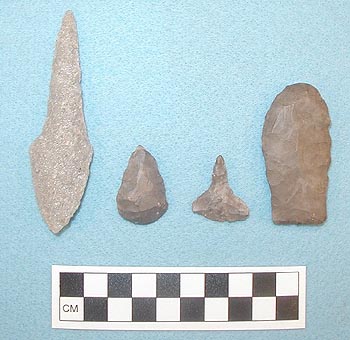
Left to Right: Quartzite Drill, Chert Scraper/Graver, Chert Drill, Chert Bifacial Hafted Scraper
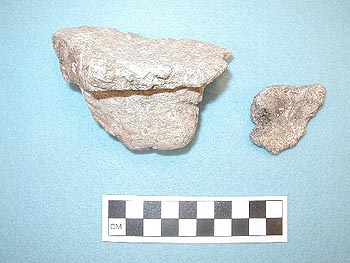
Steatite Bowl Fragments
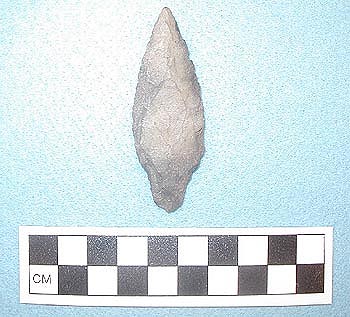
Chert Adena Point
Only one Adena point was collected from Milligan Hill. These points are, in general,
large with broad lobate stems and range between 7.6 cm and 12.7 cm (3 in and 5 in)
in length (Ritchie 1971:14). Adena points are diagnostic of the Adena culture of the
Early Woodland period, dating from approximately 800 BC to AD 800. They are found
in the Upper Ohio River valley, especially in Ohio, Kentucky, Indiana, West Virginia,
and Pennsylvania.
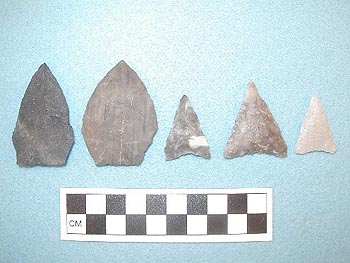
Left to Right: 2 Chert Jack's Reef Pentagonal Points, 3 Levanna Points (2 Chert and
1 Quartzite)
Four Jack's Reef Pentagonal points were collected at Milligan Hill. These points are
broad, stemless, pentagonal points and are diagnostic of the Middle Woodland period,
dating between approximately AD 500 and AD 1000. They occur in the highest frequency
in the Northeast (Justice 1987:215) Jack's Reef Corner-Notched points (n=1) are broad,
thin, corner-notched points ranging in size from 2.5 cm to 5.7 cm (1 in to 2.3 in).
They are diagnostic of the Late Middle Woodland to Late Woodland periods, dating between
approximately AD 700 and AD 1000, and are found in central New York. Levanna points
(n=3) are medium to large, fairly thin, triangular points typically diagnostic of
the Late Woodland period, dating from approximately AD 900 to AD 1500. They are generally
found throughout New York , New England, and southeastern Ontario (Ritchie 1971:31).
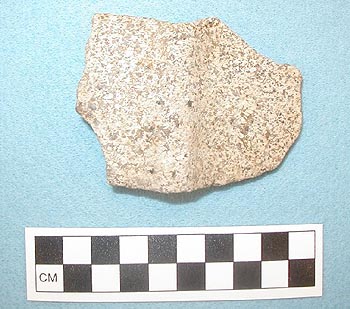
Bannerstone/Atlatl Weight
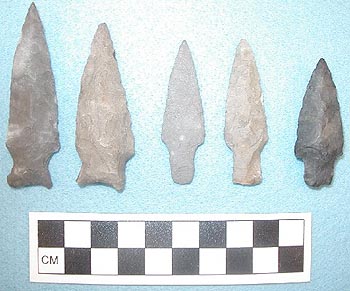
Left to Right: 2 Chert Oriental Fishtail Points, 1 Chert Poplar Island Point, 2 Chert Bare Island Points
Orient Fishtail (n=8) points are slender with a narrow blade merging into a flaring "fishtail stem" (Ritchie 1971:39). They range in size from 3.0 cm to 10.2 cm (1.2 in to 4 in) and are found in eastern and southern New York. Orient Fishtail points are diagnostic of the Late Archaic, Transitional, and Early Woodland periods, dating from approximately 1500 BC to 100 BC.
Two Poplar Island points were identified in the assemblage. Poplar Island points are medium to large, symmetrical, and have rounded shoulders and a constricted rounded stem (Ritchie 1971:44). They are typically found in the lower Susquehanna River region and are diagnostic of the Late Archaic period, dating between approximately AD 700 and AD 1000.
Bare Island points are medium-sized, finely flaked points with isosceles triangular blades and straight stems (Ritchie 1971:14). Bare Island points are diagnostic of the Late Archaic period, dating to approximately 1500 BC, and are found in the lower Susquehanna Valley. Twenty-one Bare Island points were collected from Milligan Hill.
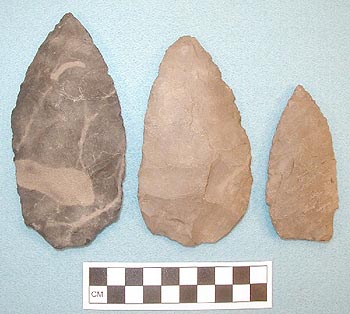
Large Chert Preforms
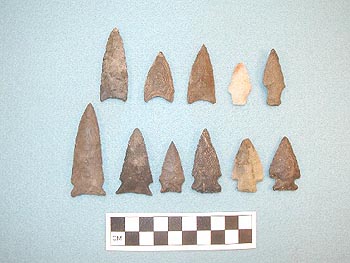
Left to Right, Top Row: 3 Chert Brewerton Eared Triangle Points, 2 Lamoka Points-Quartzite
and Chert
Left to Right, Bottom Row: 3 Chert Brewerton Eared-Notched Triangle Points, 3 Chert
Brewerton Side-Notched Points
The collection contains 10 Brewerton Eared Triangle points. These points are typically relatively thin, isosceles triangular points of small to medium size with delicately chipped ears on each side of the base (Ritchie 1971:18). Brewerton Eared Triangles are diagnostic of the Upper, Middle, and Late Archaic horizons, dating from approximately 5000 BC to 1200 BC, and are found in central and eastern New York.
The most common point type in the collection is Lamoka (n=55). Lamoka points are characteristically small, narrow, thick points diagnostic of the Late Archaic period. They date from approximately 1500BC to 1000 BC and are typically found in Western New York and Northern Pennsylvania.(Ritchie 1971:29).
Follett collected 10 Brewerton Eared-Notched points from the Milligan Hill site. These points are generally broad and thick with flanges on the base which project beyond the edges and are chipped into small "ears" (Ritchie 1971:17). They range in size from 1.9 cm to 6.4 cm (.75 in to 2.5 in) and are found in eastern and central New York. Brewerton Eared-Notched points are diagnostic of the Middle and Late Archaic periods, dating from approximately AD 500 to AD 1000.
Brewerton Side-Notched points are broad, thick, side-notched points of medium size. They are the most common point of the Archaic Laurentian Complex and date to approximately 3000 BC. They are found all over New York State (Ritchie 1971:19). Forty-three Brewerton Side-Notched points were recovered from the Milligan Hill site.
Brewerton Corner Notched points (n=4) are broad and thick, of medium size and are diagnostic of the Laurentian complex, dating to approximately 3000 BC. They are found in western and central New York (Ritchie 1971:16).
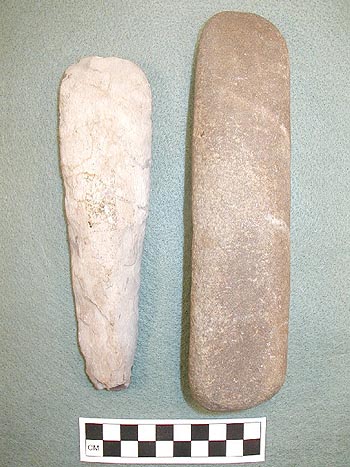
Groundstone celts
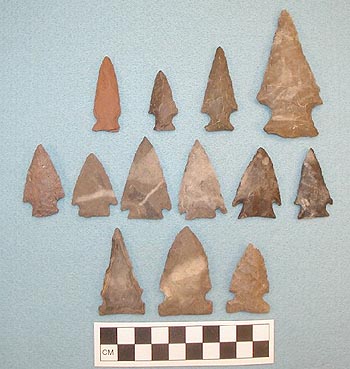
Top Row: 4 Chert Normanskill Points
Middle Row: 6 Chert Vosburg Points
Bottom Row: 3 Chert Otter Creek Points
Thirty-one Normanskill points were identified in the Milligan Hill collection. These points are generally slender, thick points of medium size, diagnostic of the Middle Archaic period, dating from approximately 2500 BC to 2000 BC (Ritchie 1971:37). They are found in Eastern New York, along the Hudson River.
Vosburg points are broad and thin with small to medium corner notches and short stems basally ground smooth (Ritchie 1971:55). Vosburg points are diagnostic of the Laurentian tradition, dating to approximately 300 BC, and are found in eastern New York. Fifteen Vosburg points were identified in the Milligan Hill assemblage.
Otter Creek points are large, thick, side-notched points with square "tangs" (Ritchie 1971:40). They range in size from 5.7 cm to 11.4 cm (2.3 in to 4.5 in) and are diagnostic of the Vergennes complex of the Archaic Laurentian period, dating from approximately 5000 BC to 3000 BC. Otter Creek points are found in highest frequency in west central Vermont. Four Otter Creek points were recovered from Milligan Hill.
Meadowood points are very thin, medium to large side-notched points diagnostic of the Early Woodland Meadowood phase (1300-500 BC; Ritchie 1971:35; Ritchie and Funk 1973:116). They are found in New York, Connecticut, Vermont, and other areas of the Northeast (Justice 1987:171). Three Meadowood points were recovered from the Milligan Hill site.
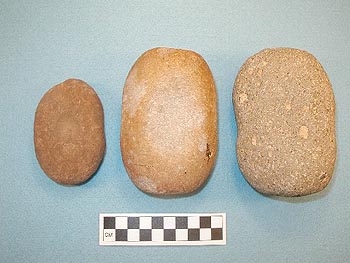
Nutting stones
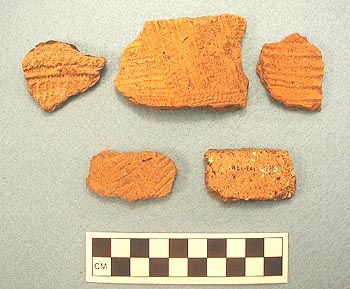
Cord-Wrapped Stick Impressed Pottery
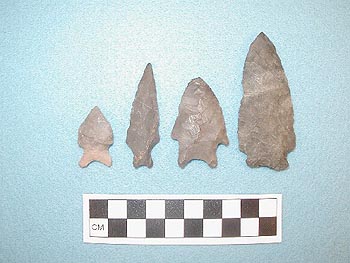
Bifurcate Base Points
These untyped points date to as early as 8000 BC.
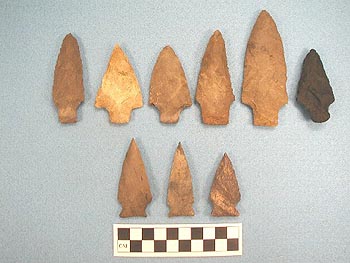
Bottom Row: 3 Susquehanna Broad Points (2 chert, 1 other)
Six Genesee points were recovered from the site. These points are typically large and thick with straight stems. They range in size from 3.8 cm to 15.2 cm (1.5 in to 6 in; Ritchie 1971:24). Genesee points are diagnostic of the Middle to Late Archaic periods, dating from approximately 2500 BC to 1500 BC, and are found in central New York
Snook Kill points are very broad, large, thick, contracted stemmed points ranging in size from 5.08 cm to 10.16 cm (2 in to 4 in; Ritchie 1971:47). Seven were recovered from Milligan Hill. Snook Kill points are diagnostic of the Late Archaic Snook Kill phase which dates from approximately 1800 to 1600 BC (Justice 1987:160). Snook Kill points occur through much of the Northeast, including New Jersey, New York, Connecticut, Massachusetts, Vermont, and Eastern Pennsylvania (Justice 1987:160).
Susquehanna Broad points (n=8) are broad spearpoints with a rough corner-notched shape. They range in size from 3.8 cm to 10.2 cm (1.5 in to 4 in; Ritchie 1971:53). Susquehanna Broad points are found in Pennsylvania's Susquehanna Valley and New York State and are diagnostic of the Transitional period, dating from approximately 1200 to 1000 BC.
References Cited
Justice, Noel D.
1987 Stone Age Spear and Arrow Points of the Midcontinental and Eastern United States. Indiana University Press, Bloomington.
Ritchie, William
1971 A Typology and Nomenclature for New York State Projectile Points. New York State Museum Bulletin Number 384, State Education Department. University
of the State of New York, Albany, New York.
Ritchie, William and Robert Funk
1973 Aboriginal Settlement Patterns in the Northeast. Memoir 20. New York State Museum and Science Service, State Education Department,
Albany, New York.